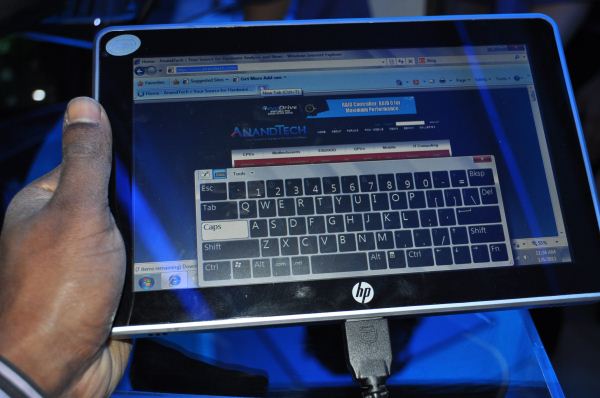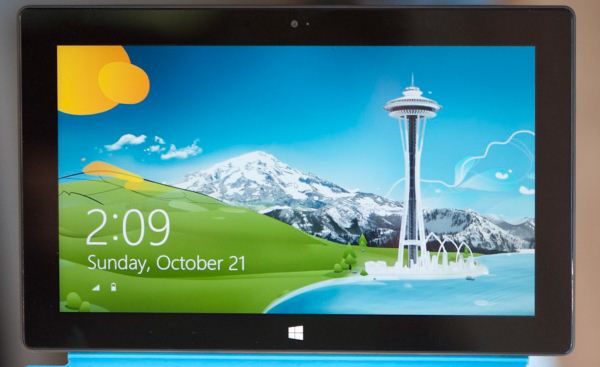The Windows RT Review
by Vivek Gowri & Anand Lal Shimpi on October 25, 2012 12:00 PM EST- Posted in
- Windows RT
- Operating Systems
- Microsoft
- Mobile
- Windows 8
- Tablets
Meet Windows RT
Microsoft’s first serious foray into tablets came just after the turn of the new millenium, with Bill Gates demonstrating the first tablet PC prototype onstage at Comdex in the autumn of 2000. From there, OEMs started releasing tablets based on Windows XP Tablet PC Edition in 2002, with a full range of pen-enabled slates and convertibles releasing over the next few years. In addition to oftentimes prohibitive cost, each had its own set of drawbacks. Convertibles tended to be quite bulky compared to their notebook counterparts (the ThinkPad X-series being a notable exception), while slates were rather difficult to use - a symptom of shoehorning a desktop operating system into a purely touch-centric form factor.
Fast forward a decade, to the beginning of 2010. After a number of conceptual non-starters in the tablet PC space - building tablet PC support into all editions of Windows Vista and 7 (other than Basic/Home Starter), the entire Origami class of devices - Microsoft’s touchscreen devices were floundering. The iPad had been announced to mixed reaction but an extremely high level of anticipation. Microsoft and HP countered with the Slate 500, an Atom-based device shown off at CES 2010 with solid state storage and Windows 7 in roughly the same form factor as Apple’s iPhone OS-based ARM tablet. With speculation pointing to a pricetag of just $549, the Slate appeared to be the most viable hope Microsoft had in trying to make mainstream headway with the tablet PC concept. But shortly after the iPad shipped in April 2010, rumors of the Slate’s demise started to circulate, and after a six month delay, the Slate 500 started shipping as an enterprise-only product in December of that year for $799. HP’s acquisition of Palm (RIP) definitely played a role in the sidelining of the Slate, but more importantly, it essentially spelled the end for the tablet PC. This was news that was perhaps known already, but the Slate saga officially pulled the plug on Microsoft’s original idea of what a tablet was.
The problem was two parts software, one part hardware. Microsoft had developed a very interesting touch-oriented user interface for its handhelds, so at least one part of the equation was relatively straightforward. The hardware issue came down to this: the iOS and Android tablets succeeding in the market ran off ARM system-on-chips, which resulted in slim, power-efficient tablets that had idle times stretching for days. At the time, there was just nothing in terms of x86 hardware that could compete with that in low-power device realm (Clover Trail and Haswell, of course, change this part of the story considerably). The other question? How to converge the touch-centric UI with the classic desktop environment that had been the corner of Windows dating all the way back to 95.
Meet Windows RT. It’s Microsoft’s first major foray into the modern tablet market, the shipping version of Windows-on-ARM, and it’s one of Microsoft’s most important product launches ever. Windows 8 shares the same touch-friendly user interface, but the ARM silicon makes RT an almost entirely tablet-centric operating system, the first for Microsoft. Combined with the focus on premium hardware experiences, this is Redmond’s most serious push to be competitive with the iOS and Androids of the world. How does it fare? Keep reading.












233 Comments
View All Comments
mcnabney - Thursday, October 25, 2012 - link
CT is still Atom. These are processors that can be massively beaten by any Core2 Duo. A typical Core2 has 3-5x the performance power - so don't get too excited about productivity yet.They need to go the iPad3 route and just jam a huge battery in it. An i3 is what tablets need.
StormyParis - Thursday, October 25, 2012 - link
Except the iPad3 has nowhere near the power of a Core i3, it's a dual (or quad core ?) ARM that has nowhere near the oomph, nor power consumption, of an i3.Musafir_86 - Thursday, October 25, 2012 - link
Hi,-Thanks for the review, but I have some (minor) things to ask:
1. What's the Windows Experience Index (WEI) score? Could you put a screen capture of the individual ratings too?
2. Is System Restore on by default? What's the default reserved space for it?
3. Would you run some demos (or as many as you can) from IE Test Drive website for both Metro IE & Desktop IE and post the resulting FPS/scores here? Then compare the same demos on Atom's Win8 tablet and also maybe an x86 desktop/laptop Win8 system.
-Your consideration is really appreciated, thanks again.
Regards.
mcnabney - Thursday, October 25, 2012 - link
You really think Microsoft would put WEI in RT? It would likely be a 1 or 2 based upon some of the weak components. Remember, an ARM CPU is really a very very very weak CPU.Musafir_86 - Thursday, October 25, 2012 - link
-Hmm, it seems you're right - WEI scores don't exist on Windows RT:http://msdn.microsoft.com/en-us/library/windows/ha...
http://msdn.microsoft.com/en-us/library/windows/ha...
-However, I still want to know about the answers for other 2 questions. :)
Regards.
faizoff - Thursday, October 25, 2012 - link
I really hope a Modern UI app is made, it would be an excellent tool especially the bench tool. There are already quite a handful of tech site apps and they do a fairly good job of placing the website in tablet format.GotnoRice - Thursday, October 25, 2012 - link
This is going to be many people's first impression of both Windows 8 and a Microsoft Tablet, and both experiences are going to be ruined by ARM.Most won't realize that the REAL surface tablet, the one that runs actual x86 programs and not a handful of glorified phone apps from the microsoft app store, isn't out yet.
cappasay - Thursday, October 25, 2012 - link
If the price was better (i.e. $100 cheaper), I would easily go for the RT. I cannot imagine the Surface Pro replacing my full-time machine anyway, both in terms of screen size (my laptop is currently 13") and raw power.karasaj - Thursday, October 25, 2012 - link
Surface Pro will run an ULV ivy bridge, so I don't really see how it can't match a 13" ultrabook in terms of power.Unless you have something that isn't an ultrabook, but in that case, ULV will always lose to non-ULV, surface or not.
arcanetribe - Thursday, October 25, 2012 - link
Anand/Vivek,I'd have liked to see an assessment of what you think RT's capabilities are as far as malware rejection and security is concerned. Is it going to be more resilient than standard Windows 8?
Obviously it will be difficult to get a user to install a trojan with the MS Store requirement, but will drive-by infections still be a concern?